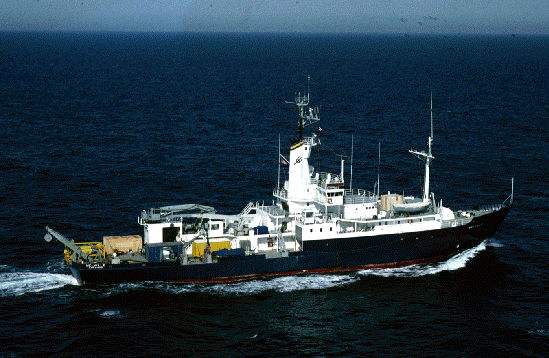
Sojourn Leg 2 Aboard the R/V Melville
Departed Papeete, Tahiti - October 28, 1996
Arrived Hanga Roa, Easter Island - December 3, 1996
The primary purpose of the cruise was to survey the narrow axial zone of the
ultrafast-spreading EPR at 17*18'-42'S using the fiber-optic ARGO II near-bottom
optical/acoustic system and the AMS-120 sonar system. Our goal was to test the
hypothesis (based on ARGO data from EPR 9-10*N) that along-strike thermal
gradients set up by the segmented pattern of magma supply to fast-spreading
MOR's exert primary control on the distribution and types of hydrothermal vents
and vent biota, as well as on variations in fine-scale volcanotectonic
characteristics along the axial zone. On the 4th order scale at EPR 9-10N, this
magmatic control of hydrothermal discharge is manifested by the concentration
of high-temperature vents along eruptive fissures. EPR 17*18'-42'S is a superb
area for further investigation of relationships between magmatic processes and
other axial processes. Along a segment of ridge only 45 kms long, seismic data
show that the axial magma chamber (AMC) changes along strike from a flat-topped
body at relatively constant depth to a peaked cupola ("spike") that intrudes to
within 0.8 km of the seafloor at 17*27'S. This represents the most extreme
along-srike variations in thermal gradients that we know of on the MOR, and
contrasts with the flat-topped AMC at EPR 9-10N. The survey was
designed (and will be interpreted) within the context of seismic
reflection/refraction data, SeaMARC II and MR1 imaging, SeaBeam bathymetry,
gravity and magnetic data, submersible observations, and extensive
petrologic/geochemical data that exist already for the study area and
adjacent ridge flanks. These data show that this apparently unsegmented portion
of the EPR is actually partitioned into at least six 4th-order segments (our
survey may reveal more), and that the axial zone exhibits along-strike
changes in morphology and some extreme along-strike changes in axial lava
compositions. Ridge morphology and some visual observations indicate recent
eruptive activity in part of the survey area. Beyond testing ideas
about coupled magmatic/hydrothermal segmentation along the MOR, we also
observed how hydrothermal and other axial zone processes are affected by
ultrafast spreading rates and extreme along-strike thermal/magmatic gradients.
We determined the nature of the axial troughs found along portions of the
axial zone in the study area (axial summit caldera or graben?) and
investigated the development of these important axial features. To this end, we
carried out a secondary Argo survey of a hydrothermally-active portion of the
axial summit trough on the segment south of the main survey area (at approx.
18.5S). Finally, we provided a baseline survey of the fine-scale
segmentation and distribution of vents and biota along a ridge segment destined
for future seismic and submersible studies.
We also collected CTD and transmissometer data using instruments mounted on
the ARGO and AMS 120 vehicles and on the towing cable.
ARGO II watches required AT LEAST 5 people. Two of the watchstanders were
designated as a dataloggers. Both people watched the real-time video and
logged observations in real time, one digitally and the other handwritten.
In this way we were able to manage the huge visual dataset. The datalogger
files were subsequently edited by verifying the logged observations with
the handwritten backup. By this means the classification of features
was standardized and erroneous data were deleted from the files. The end
product was a set of digitized and categorized GIS/ArcInfo coverages that
could be plotted in any combination (for example, black smokers and
fissures; vent communities and Age 1 lavas; etc.). This was a very powerful
approach to data management that had also worked beautifully for the EPR 9-10N
ARGO I dataset.
 Back
Back

